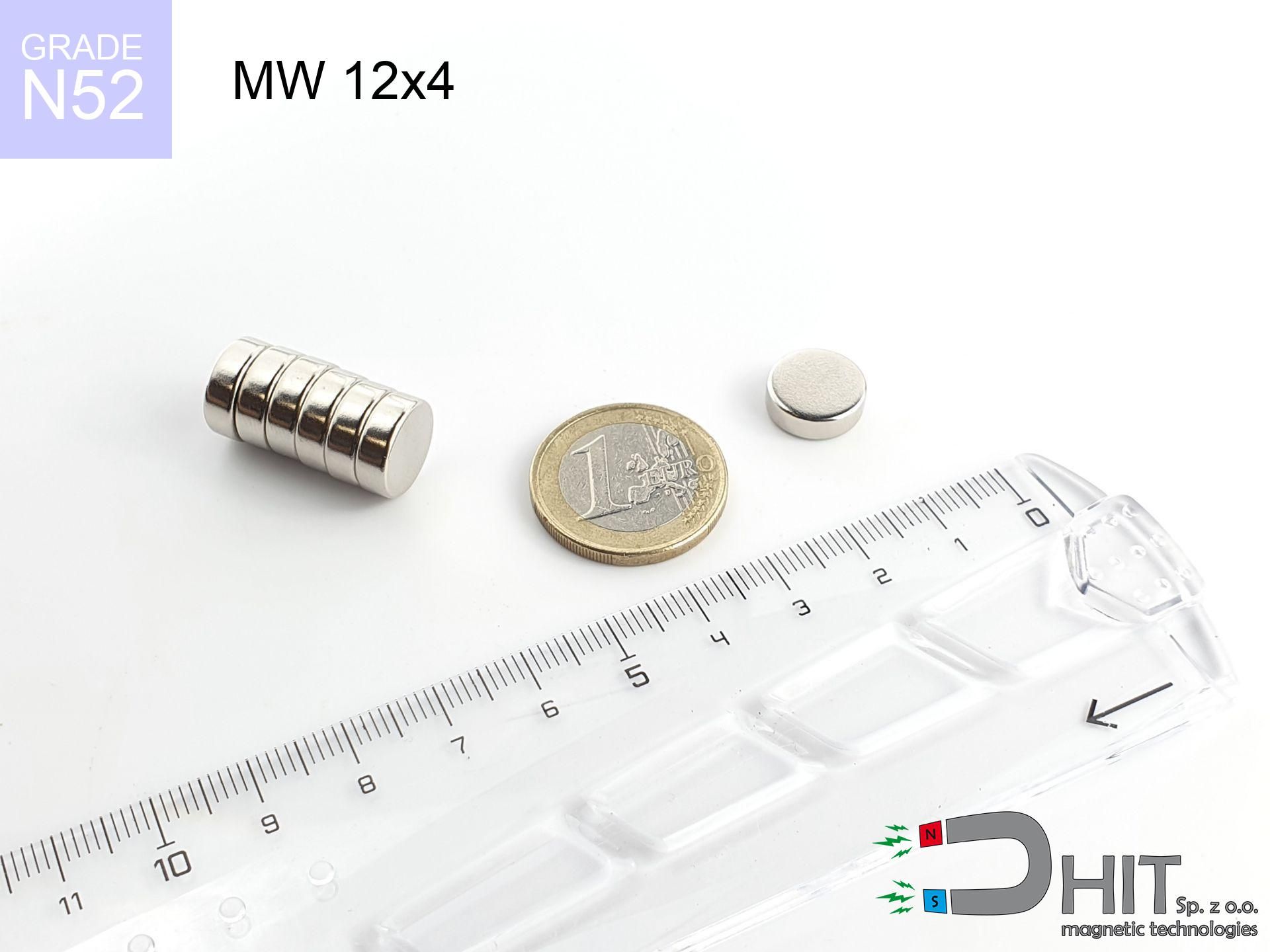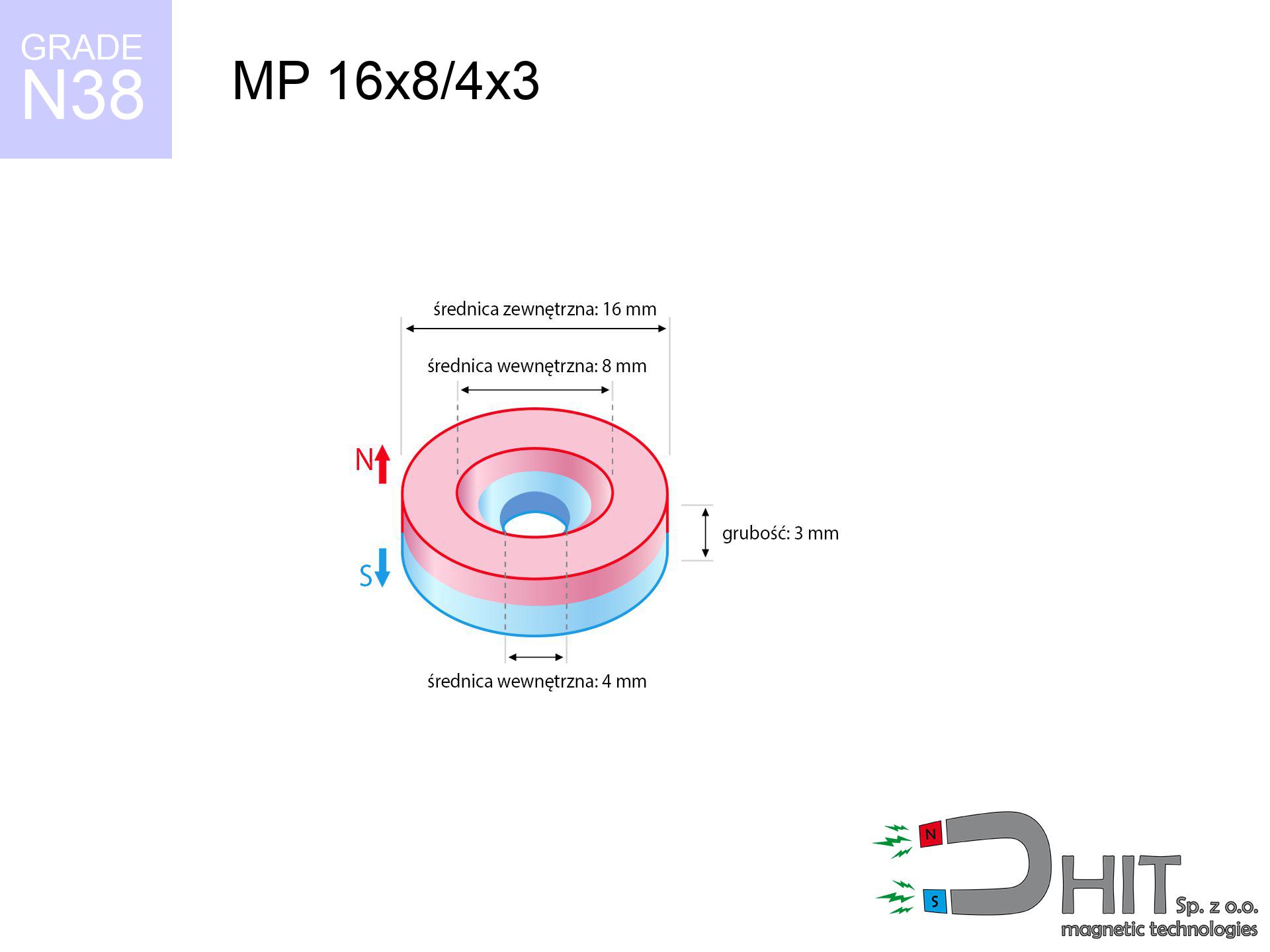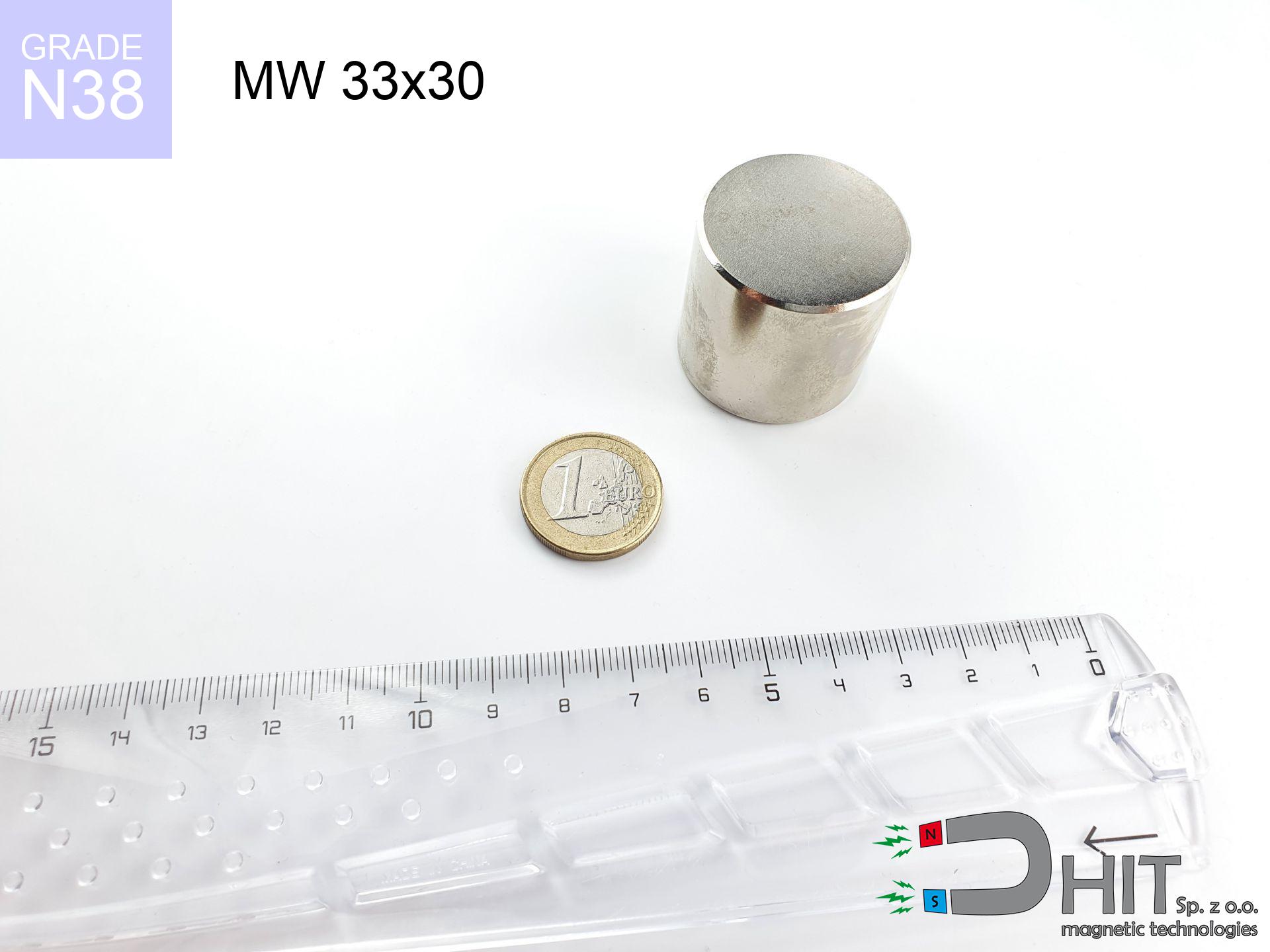MW 12x4 / N52 - cylindrical magnet
cylindrical magnet
Catalog no 010500
GTIN: 5906301814962
Diameter Ø [±0,1 mm]
12 mm
Height [±0,1 mm]
4 mm
Weight
3.39 g
Magnetization Direction
↑ axial
Load capacity
3.6 kg / 35.3 N
Magnetic Induction
400.45 mT
Coating
[NiCuNi] nickel
2.18 ZŁ with VAT / pcs + price for transport
1.770 ZŁ net + 23% VAT / pcs
bulk discounts:
Need more?Looking for a better price?
Call us now
+48 22 499 98 98
or drop us a message by means of
contact form
through our site.
Force and shape of magnetic components can be verified using our
our magnetic calculator.
Order by 14:00 and we’ll ship today!
MW 12x4 / N52 - cylindrical magnet
Magnetic properties of material N52
Physical properties of NdFeB
Shopping tips
Moreover, even though neodymium is a component of the strongest magnets, they are susceptible to corrosion in humid environments. Therefore, they are coated with a thin layer of epoxy to increase their durability. Interestingly that NdFeB neodymium magnets are about 13% lighter than SmCo magnets and, despite their power, easily break, which requires special caution during their handling. For this reason, any mechanical processing should be done before they are magnetized.
In terms of safety, there are many recommendations regarding the use of these magnets. They should not be used in acidic, basic, organic environments or where solvents are present, and also in water or oil. Furthermore, they can distort data on magnetic cards and hard drives, although data deletion using a neodymium magnet is not guaranteed.
In terms of properties in different environments, neodymium magnets are susceptible to corrosion, especially in conditions of high humidity. Therefore, they are often coated with coatings, such as gold, to preserve them from environmental factors and prolong their durability. High temperatures exceeding 130°C can cause a loss of their magnetic strength, although there are specific types of neodymium magnets that can withstand temperatures up to 230°C.
As for potential dangers, it is important to avoid using neodymium magnets in acidic conditions, basic conditions, organic or solvent environments, unless they are properly protected. Additionally, their use is not recommended in wet conditions, oil, or in an atmosphere containing hydrogen, as they may forfeit their magnetic properties.
Advantages as well as disadvantages of neodymium magnets NdFeB.
In addition to their magnetic efficiency, neodymium magnets provide the following advantages:
- Their magnetic field is maintained, and after around 10 years, it drops only by ~1% (according to research),
- They are very resistant to demagnetization caused by external magnetic sources,
- By applying a reflective layer of gold, the element gains a modern look,
- They possess significant magnetic force measurable at the magnet’s surface,
- Thanks to their enhanced temperature resistance, they can operate (depending on the geometry) even at temperatures up to 230°C or more,
- The ability for accurate shaping as well as adjustment to specific needs – neodymium magnets can be manufactured in multiple variants of geometries, which enhances their versatility in applications,
- Significant impact in new technology industries – they find application in HDDs, electric motors, clinical machines along with technologically developed systems,
- Thanks to their power density, small magnets offer high magnetic performance, in miniature format,
Disadvantages of NdFeB magnets:
- They can break when subjected to a powerful impact. If the magnets are exposed to external force, they should be placed in a metal holder. The steel housing, in the form of a holder, protects the magnet from damage while also strengthens its overall strength,
- They lose power at elevated temperatures. Most neodymium magnets experience permanent degradation in strength when heated above 80°C (depending on the dimensions and height). However, we offer special variants with high temperature resistance that can operate up to 230°C or higher,
- Due to corrosion risk in humid conditions, it is common to use sealed magnets made of synthetic coating for outdoor use,
- Limited ability to create precision features in the magnet – the use of a mechanical support is recommended,
- Potential hazard linked to microscopic shards may arise, in case of ingestion, which is notable in the context of child safety. Additionally, miniature parts from these magnets might complicate medical imaging once in the system,
- Higher purchase price is one of the drawbacks compared to ceramic magnets, especially in budget-sensitive applications
Breakaway strength of the magnet in ideal conditions – what it depends on?
The given holding capacity of the magnet corresponds to the highest holding force, determined in the best circumstances, namely:
- with the use of low-carbon steel plate serving as a magnetic yoke
- having a thickness of no less than 10 millimeters
- with a refined outer layer
- with zero air gap
- in a perpendicular direction of force
- at room temperature
Magnet lifting force in use – key factors
Practical lifting force is dependent on elements, by priority:
- Air gap between the magnet and the plate, because even a very small distance (e.g. 0.5 mm) can cause a drop in lifting force of up to 50%.
- Direction of applied force, because the maximum lifting capacity is achieved under perpendicular application. The force required to slide the magnet along the plate is usually several times lower.
- Thickness of the plate, as a plate that is too thin causes part of the magnetic flux not to be used and to remain wasted in the air.
- Material of the plate, because higher carbon content lowers holding force, while higher iron content increases it. The best choice is steel with high magnetic permeability and high saturation induction.
- Surface of the plate, because the more smooth and polished it is, the better the contact and consequently the greater the magnetic saturation.
- Operating temperature, since all permanent magnets have a negative temperature coefficient. This means that at high temperatures they are weaker, while at sub-zero temperatures they become slightly stronger.
* Lifting capacity testing was conducted on a smooth plate of suitable thickness, under perpendicular forces, however under shearing force the load capacity is reduced by as much as 5 times. Additionally, even a slight gap {between} the magnet and the plate reduces the lifting capacity.
Exercise Caution with Neodymium Magnets
Magnets made of neodymium are highly susceptible to damage, resulting in breaking.
In the event of a collision between two neodymium magnets, it can result in them getting chipped. They are coated with a shiny nickel plating similar to steel, but they are not as hard. In the case of a collision between two magnets, there can be a scattering of small sharp metal fragments in different directions. Protecting your eyes is essential.
Dust and powder from neodymium magnets are flammable.
Avoid drilling or mechanical processing of neodymium magnets. Once crushed into fine powder or dust, this material becomes highly flammable.
Neodymium magnets are the strongest magnets ever invented. Their strength can surprise you.
Make sure to review all the information we have provided. This will help you avoid harm to your body and damage to the magnets.
Under no circumstances should neodymium magnets be placed near a computer HDD, TV, and wallet.
The strong magnetic field generated by neodymium magnets can destroy magnetic media such as floppy disks, video tapes, HDDs, credit cards, magnetic ID cards, cassette tapes, or other devices. They can also destroy videos, televisions, CRT computer monitors. Do not forget to keep neodymium magnets at a safe distance from these electronic devices.
Keep neodymium magnets away from children.
Neodymium magnets are not toys. You cannot allow them to become toys for children. In such a situation, surgery is necessary to remove them. In the worst case scenario, it can result in death.
Neodymium magnets can become demagnetized at high temperatures.
Although magnets have demonstrated their effectiveness up to 80°C or 175°F, the temperature can vary depending on the type, shape, and intended use of the specific magnet.
People with pacemakers are advised to avoid neodymium magnets.
Neodymium magnets generate strong magnetic fields. As a result, they interfere with the operation of a pacemaker. This happens because such devices have a function to deactivate them in a magnetic field.
Neodymium magnets can attract to each other, pinch the skin, and cause significant injuries.
Neodymium magnets bounce and clash mutually within a distance of several to almost 10 cm from each other.
The magnet is coated with nickel. Therefore, exercise caution if you have an allergy.
Studies show a small percentage of people have allergies to certain metals, including nickel. An allergic reaction often manifests as skin redness and rash. If you have a nickel allergy, try wearing gloves or avoid direct contact with nickel-plated neodymium magnets.
Never bring neodymium magnets close to a phone and GPS.
Neodymium magnets generate strong magnetic fields that interfere with magnetometers and compasses used in navigation, as well as internal compasses of smartphones and GPS devices.
Caution!
In order for you to know how strong neodymium magnets are and why they are so dangerous, read the article - Dangerous powerful neodymium magnets.




![SM 18x100 [2xM5] / N42 - magnetic separator SM 18x100 [2xM5] / N42 - magnetic separator](https://cdn3.dhit.pl/graphics/products/sm-18x100-2xm5-pem.jpg)

![BM 380x180x70 [4x M8] - magnetic beam BM 380x180x70 [4x M8] - magnetic beam](https://cdn3.dhit.pl/graphics/products/bm-380x180x70-4x-m8-wex.jpg)

